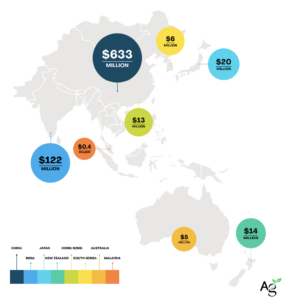Microbiomes are all around us—and even inside us. According to The Human Microbiome Project, tens of trillions of the little cells live on and inside humans. Representing thousands of species, microbiomes outnumber our own cells by roughly 10 to 1. Also living in soil and water, the single-celled organisms are so small that a few million of them can fit inside the eye of a needle. As the oldest form of life on Planet Earth, early microbe fossils date back over 3.5 billion years to a time when our world consisted of boiling oceans.
Now, researchers are turning their attention toward unlocking the mysteries behind these microscopic cell systems and exploring their potential uses for a host of different applications, including agriculture. Humans have been scratching at the surface of the intricate relationship between microbiomes and successful harvests for thousands of years. According to history, Romans learned that incorporating certain crops like clover and alfalfa in their planting rotations led to better yields for other crops. Little did the Roman farmers know that clover and alfalfa attract bacterial microbiomes that lead to enhanced soil nitrogen content.
The word microbiome literally means “tiny living community.” These microscopic environments consist of many different things, including bacteria, archaea, fungi, and protists. Lesser-known archaea are similar to bacteria while protists include primitive algae, amoebas, slime molds, and protozoa. Although there is some debate regarding whether viruses constitute a living creature, some scientists list them among microbiomes.
Based on what we know so far, microbiomes are essential to human life. Without them, we would not be able to digest food, and neither would animals. Plants would not grow, garbage would not decompose, and the air would have a lot less oxygen. Some studies have even concluded that a strong microbiome in a person can help fend off depression and prevent food allergies from developing.
Scientists and researchers already made a number of discoveries when it comes to microbiomes role in crop production. For example, University of North Carolina at Chapel Hill plant immunologist Jeff Dangl led a team of researchers who determined that soil bacteria play a huge part in determining when a wild plant from the mustard family will flower. This finding could have significant future applications for helping farmers pinpoint when their crops will reach certain stages, or even give farmers tools to regulate when those transitions occur.
Over the last several years, major agriculture companies like Bayer Crop Science, Monsanto, and Novozymes have invested over $2 billion in research and development in the field of microbiomes. The outcomes of some of these research efforts have shown the incredible potential of harnessing microbiomes, particularly when it comes to meeting the ever-growing global demand for food. Novozymes, for example, recently completed construction of a new facility dedicated to developing microbial cocktails that act like pesticides while supporting plant growth.
Studying the way microbiomes work in water has shown particular promise when it comes to finding potential uses for these tiny cell systems. The Shedd Aquarium, for example, has set out to conduct the world’s first comprehensive look at microbiomes in a controlled aquarium ecosystem. In February 2015, Shedd announced the launch of the Aquarium Microbiome Project (AMP), which is focused on determining how these cell systems influence complex environmental conditions and animal health.
Early this week, the Chicago-based project announced that it received a $2 million commitment from The Grainger Foundation, which will be used to advance AMP’s planned research by nearly a decade, enabling the expansion of Shedd’s unique on-site aquatic microbial ecology laboratory and bioinformatics capabilities.
According to AMP Project Director Dr. Bill Van Bonn, “This funding is significant to uncovering mysteries surrounding the tiny, living organisms that are all around us, how they influence the well-being of animals and their homes, and most importantly, how those discoveries may lead to important advances that benefit human health overall.” Partners in the endeavor include the United States Department of Agriculture, the Illinois Institute of Technology, and the Argonne National Laboratory.
Aquariums in particular offer a unique opportunity to study microbiomes in their natural or “wild-type” environments. Shedd’s controlled system, with inputs, outputs, and processes that are accurately known and precisely documented with years of high-confidence data, enable the researchers to explore how changes in the environmental parameters create impacts throughout the broader system.
Dr. Van Bonn anticipates that the results of the study will translate to broader native ecological management decisions impacting the Earth’s rivers, lakes and oceans. Considering that 70 percent of the Earth consists of water, exploring microbiomes in their aquatic environments could unlock a limitless body of knowledge. The project’s findings could also lead to a better understanding of how farmers and ranchers can regulate water quality and manage the environmental conditions necessary for optimal animal health.
Microbiome-based technology may also soon play a part in helping plants derive nitrogen from the air. Known as nitrogen fixing, this process involves extracting free nitrogen from the atmosphere and converting—or fixing—it into nitrogen compounds that serve as plant nutrients. Soil bacteria, blue-green algae, and lightening flashes have been helping plants obtain nutrients through nitrogen fixing for hundreds of thousands of years. Figuring out exactly how microbiomes participate in this process and pinpointing the key conditions or cells that create optimal nitrogen fixing could help farmers produce more food with less fertilizer inputs.
Have news or tips? Email [email protected].















Sponsored
International Fresh Produce Association launches year 3 of its produce accelerator